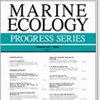Resilience of coastal marine metacommunities to increasing hydraulic connectivity
IF 2.1
3区 环境科学与生态学
Q2 ECOLOGY
引用次数: 0
Abstract
ABSTRACT: Coastal ecosystems typically comprise water patches of different salinities that host distinct communities of species. This salinity-driven heterogeneity can be vulnerable to changes in between-patch connectivity due to altered water levels. Despite the potentially grave implications for higher trophic levels, the impact of increased connectivity on phytoplankton assemblages is largely unknown. Here, we investigate the effect of increasing connectivity on assemblage resistance and recovery along a strong salinity gradient of 40-61 psu. We deployed mesocosms within a saltwork system and hydraulically connected enclosures of 3 salinity levels at 3 connectivity levels. We hypothesized that assemblage composition of high salinity would be more resistant to press invasions during connectivity; however, high connectivity would decrease compositional resistance and recovery irrespective of salinity. We found that high salinity assemblages were indeed more resistant and recovered better at low connectivity. High connectivity also impacted the function of high salinity assemblages by replacing large diatoms with small flagellates, preventing assemblage recovery. Counterintuitively, low salinity assemblage composition recovered better at higher connectivity, and this was attributed to rescue effects of rarer and stenohaline species within a more variable nutrient environment. Here, we show that normal (i.e. marine) salinity assemblages are vulnerable to anticipated changes in coastal hydrological regimes whereas higher salinity assemblages are impacted above a certain connectivity threshold.沿海海洋元群落对水力连通性增加的适应能力
摘要:沿海生态系统通常由不同盐度的水域斑块组成,这些水域斑块承载着不同的物种群落。这种由盐度驱动的异质性很容易受到水位变化导致的斑块间连通性变化的影响。尽管连通性的增加可能会对较高营养级产生严重影响,但其对浮游植物群落的影响在很大程度上还不为人所知。在此,我们沿着 40-61 psu 的强盐度梯度,研究了增加连通性对组合抵抗力和恢复力的影响。我们在 3 个连通性水平下的 3 个盐度等级的盐场系统和水力连接围栏内部署了中观模拟实验。我们假设,在连通过程中,高盐度的集合体成分将更能抵抗压力入侵;然而,无论盐度如何,高连通性都会降低成分抵抗力和恢复力。我们发现,在低连通性条件下,高盐度集合体的抵抗力和恢复能力确实更强。高连通性也会影响高盐度集合体的功能,用小鞭毛藻取代大硅藻,阻碍集合体的恢复。与直觉相反的是,低盐度集合体的组成在高连通性条件下恢复得更好,这归因于在更多变的营养环境中稀有物种和盐碱物种的拯救效应。在这里,我们表明,正常盐度(即海洋盐度)的生物群落很容易受到沿海水文系统预期变化的影响,而高盐度生物群落在超过一定的连通性阈值时则会受到影响。
本文章由计算机程序翻译,如有差异,请以英文原文为准。
求助全文
约1分钟内获得全文
求助全文
来源期刊

Marine Ecology Progress Series
环境科学-海洋学
CiteScore
5.30
自引率
8.00%
发文量
238
审稿时长
3 months
期刊介绍:
The leading journal in its field, MEPS covers all aspects of marine ecology, fundamental and applied. Topics covered include microbiology, botany, zoology, ecosystem research, biological oceanography, ecological aspects of fisheries and aquaculture, pollution, environmental protection, conservation, and resource management.
 求助内容:
求助内容: 应助结果提醒方式:
应助结果提醒方式:


